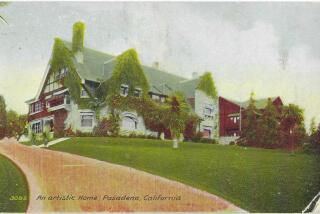Giving New Meaning to ‘Historic House’
- Share via
LONDON — If you’re not exhausted after visiting Dennis Severs’ East London home, he isn’t happy.
But there’s good reason to be tired; you have just witnessed 200 years of the British Empire’s rise and fall.
Severs, a native Californian, has spent the last 16 years crafting the 10 rooms of his dilapidated 18th-century town house into a “still-life drama.”
Each room appears as if it had just been abandoned by its 18th- and 19th-century occupants. Half-eaten food rests on the tables, fires still burn, chamber pots wait to be emptied.
You can smell the biscuits that have been warmed on the fire, and hear the rhythmic clip-clop of horseshoes on cobbled streets outside.
“It’s not about what you see but what you have only just missed and are being asked to imagine,” Severs says.
In a one-man tour de force lasting three hours, Severs uses the house as a ghostly backdrop to five generations of the Jervises, a fictional family of silk weavers.
Their story encapsulates the history of the Spitalfields neighborhood, home to Huguenot craftsmen who prospered in Georgian times but whose fortunes spiraled downward during the 19th century. The neighborhood’s reputation wasn’t helped by Jack the Ripper’s reign of terror on its streets.
As a Severs evening begins, rooms are filled with the aura of a prosperous, arrogant family. By the end, visitors reach the shabby home of a tired, seemingly eccentric schoolmistress.
In the dank candlelit basement at the start of the journey, Severs instructs guests to “get the 20th century out of your eyes, your nose, your ears, your bones, everything.”
Severs, 48, became fascinated with things English at a young age, and was spurred on by his discontent with California life.
“In America I could see we had everything materially, but it wasn’t life as I’d seen it or imagined it in films, nursery rhymes or fairy tales.”
His project is all about bringing imagination to life, Severs says.
His strategy is to wear visitors down, the better to nudge them along. “You won’t just accept it unless your mind is tired. It’s a form of hypnotism.”
He tells guests: “I’m going to take you through some frames into a number of inhabited historical pictures.”
After ushering them into a room, Severs leaves them to a voice of his own recording, talking at breakneck speed, weaving the Jervises’ saga.
In a cramped room on the second floor, a William Hogarth painting of men smoking depicts a scene of late-night disarray, with spilled glasses, overturned chairs and smoldering pipes.
The room itself, guests soon realize, replicates the painting minus the men. Every detail is accounted for: the position of the overturned chairs, the style of the coat hanging on a peg, the cluster of long-stemmed pipes on the table.
The smell of tobacco is pungent, and you can hear the muffled sound of a servant girl clearing dishes elsewhere in the house.
“You have to throw yourself into the rooms, and let them conquer you,” Severs says. “The art is here; Hogarth only made things flat.”
The impact of the experience is powerful, and through word of mouth it has become a popular offbeat destination for visitors willing to pay the $48 entrance fee for the dramatized evenings.
The house, Severs’ residence, is also open once a month for visitors to tour on their own for $8.
Severs is anxious to distance his creation from the historic homes circuit. “I don’t want to get stuck in the heritage rut--because those people don’t take us anywhere,” he said.
“The fun of this house is that it makes you look more round-edged at your own intelligence to see what it’s made of. The people who get this house are slick, smart criminals,” he says.
More to Read
Sign up for The Wild
We’ll help you find the best places to hike, bike and run, as well as the perfect silent spots for meditation and yoga.
You may occasionally receive promotional content from the Los Angeles Times.





